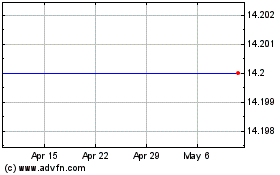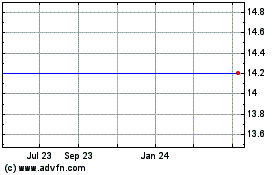Global Dairy Prices Rise as Herds Are Culled
August 17 2016 - 4:50AM
Dow Jones News
Global dairy prices have risen nearly 17% in four weeks, an
encouraging sign for a sector beleaguered globally by low prices
and growing stockpiles of cheese and milk powder.
After hovering at historically low levels for much of 2016,
prices have finally started to rally as farmers have culled herds
to save money, reducing the available milk.
The GlobalDairyTrade Price Index, which covers a variety of
products and contract periods in the auction, rose 12.7% from the
previous auction on Aug. 2. The index is now at its highest level
since Oct. 20, 2015.
The GlobalDairyTrade auction is an international trading
platform established by New Zealand's Fonterra Co-Operative Group.
The average selling price was $2,731 a metric ton. It is closely
watched, as the GDT Price Index is widely considered a market
reference price for dairy products.
"The lift over the two August auctions is the first verification
of our view that rapidly tightening global supply will lift prices
over 2016. We expect further price lifts over the rest of 2016,
contingent supply weakness continuing," ASB Bank economist Nathan
Penny said in a note.
Having risen nearly threefold from 2009 to 2014, milk prices
halved earlier this year as farmers increased dairy supplies to try
to cash in on an expected surge in demand from China and the Middle
East. The situation got worse when Russia banned imports of food
from the U.S., Australia, Canada and Europe in August 2014, cutting
off a market for dairy and increasing the surplus.
But that surplus is waning.
New Zealand, the world's largest dairy exporter, saw production
fall 1.6% in the year to May 31, while production in Australian
fell 2.0% in the year to June 30. In Europe, production is slightly
higher year over year, but isn't at levels seen earlier this year,
according to data from the European Commission.
"We suspect the market is now factoring in a sizable decline in
New Zealand milk production. This no doubt added to the massive
18.9% lift in whole-milk powder prices," said Doug Steel, an
economist at Bank of New Zealand. New Zealand's major export is
whole-milk powder.
Production has fallen as farmers, many of whom have been
operating below the cost of production, have been forced to send
cows to the slaughterhouse to raise revenue and reduce spending
rather than continuing to milk them. Furthermore, supplementary
feeding, which increases milk yield but isn't necessary, has been
reduced to cut costs.
"The only one bucking the trend of late has been the U.S. But
even in the U.S., there are signs softer prices are likely to weigh
on future production," said Anne Boniface, an economist at Westpac
Banking Corp. in New Zealand.
The U.S. Department of Agriculture last month lowered the U.S.
forecast for milk production in 2016 by 0.2 billion pounds to 212.4
billion pounds due to a fall of the county's herd.
Improved demand from China is also playing a role in pushing
prices higher, analysts say, noting that concerns prices could rise
rapidly are stoking interest.
"We sense this auction result has a bit of panic buying in it,"
Mr. Steel said.
Write to Lucy Craymer at Lucy.Craymer@wsj.com
(END) Dow Jones Newswires
August 17, 2016 04:35 ET (08:35 GMT)
Copyright (c) 2016 Dow Jones & Company, Inc.
Westpac Banking (NYSE:WBK)
Historical Stock Chart
From Mar 2024 to Apr 2024

Westpac Banking (NYSE:WBK)
Historical Stock Chart
From Apr 2023 to Apr 2024
